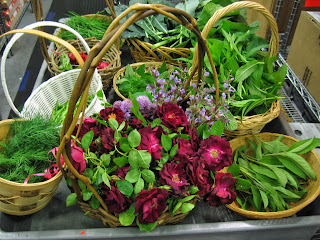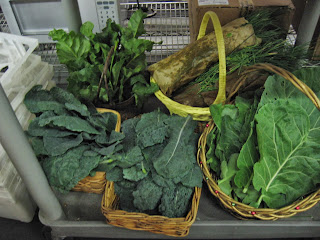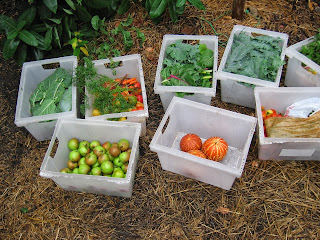One benefit of being remiss with regular blog updates is that I get to post an entire season's pictures at once. Following are photos of the bike cart as it became increasingly laden through the season, as well as the how the garden's produce appeared after I arranged it for the pantry.
The pantry volunteers have started to tease me about the growing fussiness with which I market the fruit and vegetables from the garden. I now do everything except photograph a handful of tomatoes being tossed through a sheet of water.
June 1 - radishes and flowering chives
June 8 - radishes and greens
June 15 - greens, peas, roses, and flowering herbs
June 22: It is not until you grow oregano that you realize how lovely the herb is in flower.
June 29 - The greens begin to arrive in earnest.
July 6 - Our boxes stack three high in the delivery cart.
July 13 - Greens, radishes, raspberries, and peas begin to crowd the market cart.
July 20 - Kale and collards are the quiet folk at the party over whose shoulders everyone peers, wondering when the tomatoes will show. They'll stay around and help rearrange the furniture long after the tomatoes have moved on to the next thing.
July 27 - Heads of lettuce, kale, beets, gooseberries, and the first of (frustratingly) only a half dozen heads of broccoli that we will eventually harvest this season. An hour before these pictures were taken, these vegetables and fruit were still in the ground or on a bush.
August 3 - Nearly 20 pounds of kale and other greens are overshadowed by a small basket's worth of cherry tomatoes.
August 10 - Our harvest has started to diversify, with beans, turnips, and carrots joining the weekly bounty of greens. Sick of the way that the wandering onions were taking over part of the garden, we harvested them all. They taste similar to shallots.
August 17 - Artichokes, beans, tomatoes, purple carrots, chard, kale, collards, and garlic chives
August 24 - Pole and bush beans, tomatoes, cabbages, and the stalwart kale
August 31 - Tigger melons, the first apples of the year, a few cucumbers, and our kale and collards. Of more interest, of course, are the tomatoes.













































































